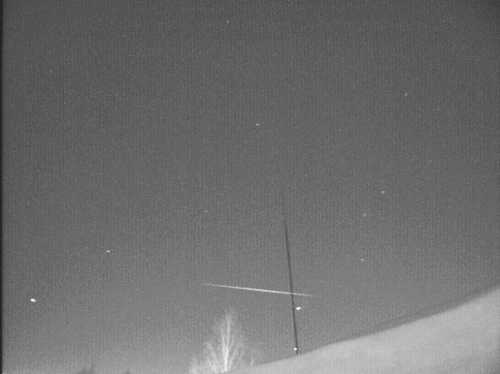
It's a calm and peaceful night. Stars twinkle in the velvety darkness overhead as a distant plane blinks silently on the horizon. You could almost hear a pin drop.
That is, until the flare.
High overhead, out of the darkness, a bright light surges into view. For five to 10 seconds it outshines the brightest stars in the sky, mimicking a supernova, perhaps even casting faint shadows at your feet. The silence is broken by your own excited shouts.
Could this happen to you?
“It could, if you happen to be outside when NanoSail-D flies by,” said Dean Alhorn of the Marshall Space Flight Center in Huntsville, AL. “We think the spacecraft could produce this kind of display from time to time when sunlight glints off the reflective fabric of its solar sail.”
On Jan. 21, NanoSail-D unfurled a 10 m2 sail 650 km above Earth's surface, becoming the first solar sail to orbit our planet.
For the next few months it will skim the top of the atmosphere, slowly descending in a test of “drag sails” as a means of de-orbiting space junk.
If all goes as planned, the spacecraft will disintegrate like a meteor in April or May of 2011, dispersing harmlessly more than 100 km high.
Meanwhile, sky watchers should be alert for flares.
Many people have already seen Iridium flares – brilliant flashes of sunlight glinting off the flat antennas of Iridium communication satellites.
Some Iridium flares are so bright, they can be seen in broad daylight. NanoSail-D could be even brighter.
“The surface area of our sail is six times greater than that of a single Iridium antenna,” pointed out Alhorn. “Plus, we're closer to Earth. It all adds up to a much brighter flash.”
As NanoSail-D gets closer to Earth, it could theoretically produce flashes of light 10 to 100 times (2.5 to 5 astronomical magnitudes) brighter than the planet Venus. That's the sort of thing you can see even through city lights.
In between flares, however, the sail is fairly dim. Internationally-recognized satellite tracking expert Ted Molczan describes what he and others have been seeing:
“NanoSail-D can be a challenging object to spot, but by no means impossible,” said Alhorn. “At its faintest, it has been invisible even in large binoculars, but at its brightest, it has been seen easily with the un-aided eye. The great variation in brightness is due to its shape; it is a large, thin sheet of highly reflective material. Seen edge-on, it is faint, but seen face-on at a favorable sun-angle, it may rival the brightest stars.”

NanoSail-D flyby predictions may be found in several places on the Web: Heavens-Above, Spaceweather.com and Calsky among others. These sites will tell you when the sail will soar overhead – but not when it will flare. The orientation of the sail isn't known precisely enough for that.
“Because it is impossible to predict exactly when NanoSail-D will be bright, observers can increase their chance of success by watching over a period of least several minutes,” said Molczan. “A plot of its predicted path on a star chart, with annotations of the time at intervals of one minute or so, will help the observer stay focused on the satellite's approximate position as it moves across the sky. Observe with the unaided eye, or binoculars with a wide field of view, like 7x50s.”
The brightest flares are likely to occur when the spacecraft is near the horizon. Former NanoSail-D principal investigator Mark Whorton (previously at NASA, now at Teledyne) explains why.
“Early in the mission NanoSail-D will be tumbling, so it really doesn't matter where it is in the sky. Flashes might occur almost anywhere along its path,” said Whorton. “But later in the mission it will be aerodynamically stabilized: the flat surface of the sail will face forward, much like the sail on a terrestrial sailing ship. That means you will see it edge on (dim) when it is directly overhead and face on (bright) when it is closer to the horizon.”
So check the predictions, go outside and take a look. Said Alhorn, “You might see something worth shouting about.”
To encourage amateur astronomers to monitor the sail, NASA and Spaceweather.com have joined forces to stage a photo contest.
Cash prizes ranging from $100 to $500 are being offered for best images of NanoSail-D submitted between now and the time the sail disintegrates. High-resolution telescopic images of the spacecraft, wide-angle shots of NanoSail-D soaring overhead, and lucky-shots of flares are all eligible. Visit www.nanosail.org for complete details.
Visit the NanoSail-D home page at www.nasa.gov/mission_pages/smallsats/nanosaild.html .
Dr. Tony Phillips works for the National Aeronautic and Space Administration.
Follow Lake County News on Twitter at http://twitter.com/LakeCoNews , on Facebook at http://www.facebook.com/pages/Lake-County-News/143156775604?ref=mf and on YouTube at http://www.youtube.com/user/LakeCoNews .


 How to resolve AdBlock issue?
How to resolve AdBlock issue? 





